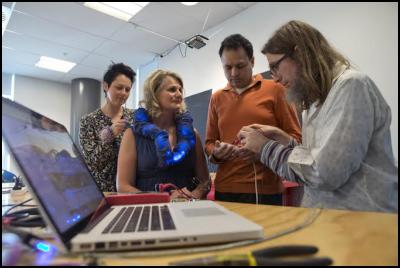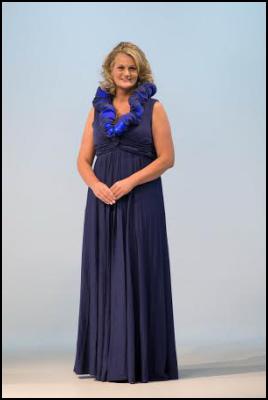AUT’s Emotion Sensing Fashion
Wearing Your Heart on Your Sleeve with AUT’s Emotion Sensing Fashion

Sarah Trotman likes to make a statement and as Director of Business Relations at AUT Business School, she is prepared to go the extra mile to show the capabilities of her university.
So for this year’s Westpac "Women of Influence” awards, when she wanted something special to wear, she challenged AUT Colab to do something that stole the show.
While she’s not one to wear her heart on her sleeve, the result was a garment that is connected to her nervous system using Galvanic Skin Response Technology and changes colour depending on her stress levels.
That means a bright blue collar turns mauve and grows in intensity when she’s nervous or embarrassed! Great stuff. Hilarious when friends try to tease her to get a colour change to happen!
The garment was created by two Colab PhD students at AUT University, Donna Cleveland and Amit Gupta and overseen by creative technologist Kim Newall. It is made from merino wool and knitted at the AUT Textile Design Lab, and except for a few electrodes that and battery packs to drive the garment, it’s all natural and recyclable.
It
was test driven when Sarah MCd the AUT Business School
Excellence in Business Support Awards at the Langham Hotel
last week, but with final modifications to intensify colour
changes, she wore it to the Westpac Women of Influence
Awards event on Wednesday night.
Sarah, a finalist from
last year’s awards, this time presented the award for the
Business Entrepreneur category.
“The garment itself was gorgeous to wear – expect for the battery packs,” laughs Sarah.

“And I must admit some of the colour changes and the reactions of fellow guests did make me feel somewhat self-conscious,” she said.
“But it was quite surreal to be wired up with sensors in that way and was an amazing experience throughout.”
This garment might be a party trick for now, but it is possibly the future of clothing. And while fashion might be a pretty way to show off the technology, industrial and sporting uses are more likely in the short to medium term.
“Imagine a garment that can display health issues of a disabled person, warn a worker of extreme fatigue, or a sportsman of heart or brain injury,” says Donna Cleveland of Colab, one of the garment’s creators.
“This technology will become commonplace in future, but it may surprise us all as to the actual uses,” she said.
Having had its big night out, the garment now heads off to be displayed at an international conference on wearable technology, ArchInTex in Eindhoven, The Netherlands.
After that it will be reduced to its components and fully recycled into another garment, perhaps with technology as yet undiscovered.
ENDS


 Shearing Sports NZ: Shearing Them Around - 11 Shearing Records In 2024
Shearing Sports NZ: Shearing Them Around - 11 Shearing Records In 2024 The New Zealand Retro: Special End Of Year Retro Chart Show On Independent Radio Stations
The New Zealand Retro: Special End Of Year Retro Chart Show On Independent Radio Stations ASB Polyfest: Polyfest’s 50th Celebrations On Track Despite Funding Cuts
ASB Polyfest: Polyfest’s 50th Celebrations On Track Despite Funding Cuts Air New Zealand: Raw Thrills - Air New Zealand's Most Popular Inflight Entertainment Revealed
Air New Zealand: Raw Thrills - Air New Zealand's Most Popular Inflight Entertainment Revealed Hustle Management: Celebrating 50 Years Of Music, Now And Then, With Mark Williams
Hustle Management: Celebrating 50 Years Of Music, Now And Then, With Mark Williams Massey University: Birdnapped Cockatoo Wins Quote Of The Year
Massey University: Birdnapped Cockatoo Wins Quote Of The Year